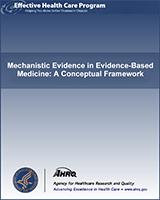NCBI Bookshelf. A service of the National Library of Medicine, National Institutes of Health.
Structured Abstract
Background:
Virtually all current frameworks for the evaluation of the strength of evidence for an intervention’s effect focus on the quality of the design linking the intervention to a given outcome. Knowledge of biological mechanism plays no formal role. In none of the evidence grading schemas, new statistical methodologies or other technology assessment guidelines is there a formal language and structure for how knowledge of how an intervention works.
Objectives:
The objective was to identify and pilot test a framework for the evaluation of the evidential weight of mechanistic knowledge in evidence-based medicine and technology assessment.
Methods:
Six steps were used to develop a framework for the evaluation of the evidential weight of mechanistic knowledge: (1) Focused literature review, (2) Development of draft framework, (3) Workshop with technical experts, (4) Refinement of framework, (5) Development of two case studies, (6) Pilot test of framework on case studies.
Results:
The final version of the framework for evaluation of mechanistic evidence incorporates an evaluation of the strength of evidence for the:
- Intervention’s target effect in nonhuman models.
- Clinical impact of target effect in nonhuman models.
- Predictive power of nonhuman model for an effect in humans
- 3t.
The predictive power of the target effect model
- 3c.
The predictive power of the clinical effect model
- Intervention’s target effect in human disease states.
- Clinical impact of the target effect in human disease states.
A graphic representation is included in the full report.
Conclusion:
This framework has several features combining work from a variety of fields that represent an important step forward in the rigorous assessment of such evidence.
- It uses a definition of evidence based on inferential effect, not study design.
- It separates evidence based on mechanistic knowledge from that based on direct evidence linking the intervention to a given clinical outcome.
- It represents the minimum sufficient set of steps for building an indirect chain of mechanistic evidence.
- It is adaptable and generalizable to all forms of interventions and health outcomes.
It mirrors in the evidential framework the conceptual framework for translational medicine, thus linking the fields of basic science, evidence-based medicine and comparative effectiveness research.
Contents
- Preface
- Acknowledgments
- Executive Summary
- Background
- Objective
- Methods
- Results and Case Studies
- Discussion
- Limitations and Future Research
- Conclusions
- References
- Appendix A Annotated Bibliography of Animal Models Literature With Framework Mapping
- Appendix B Annotated Bibliography of Surrogate Endpoints Literature, With Framework Mapping
- Appendix C Workshop Proceedings Biological Mechanisms in Evidence-Based Medicine
Prepared for: Agency for Healthcare Research and Quality, U.S. Department of Health and Human Services1, Contract No: 290-2007-10061-I, Prepared by: The Johns Hopkins University Evidence-based Practice Center, Baltimore, MD
Suggested citation:
Goodman SN, Gerson J. Mechanistic Evidence in Evidence-Based Medicine: A Conceptual Framework. Research White Paper (Prepared by the Johns Hopkins University Evidence-based Practice Center under Contract No. 290-2007-10061-I). AHRQ Publication No. 13-EHC042-EF. Rockville, MD: Agency for Healthcare Research and Quality. June 2013. www.effectivehealthcare.ahrq.gov/reports/final.cfm.
This report is based on research conducted by the The Johns Hopkins University Evidence-based Practice Center (EPC) under contract to the Agency for Healthcare Research and Quality (AHRQ), Rockville, MD (Contract No. 290-2007-10061-I). The findings and conclusions in this document are those of the authors, who are responsible for its contents; the findings and conclusions do not necessarily represent the views of AHRQ. Therefore, no statement in this report should be construed as an official position of AHRQ or of the U.S. Department of Health and Human Services.
The information in this report is intended to help health care decisionmakers—patients and clinicians, health system leaders, and policymakers, among others—make well informed decisions and thereby improve the quality of health care services. This report is not intended to be a substitute for the application of clinical judgment. Anyone who makes decisions concerning the provision of clinical care should consider this report in the same way as any medical reference and in conjunction with all other pertinent information, i.e., in the context of available resources and circumstances presented by individual patients.
This report may be used, in whole or in part, as the basis for development of clinical practice guidelines and other quality enhancement tools, or as a basis for reimbursement and coverage policies. AHRQ or U.S. Department of Health and Human Services endorsement of such derivative products may not be stated or implied.
None of the investigators have any affiliations or financial involvement that conflicts with the material presented in this report.
- 1
540 Gaither Road, Rockville, MD 20850; www
.ahrq.gov
- NLM CatalogRelated NLM Catalog Entries
- Mechanistic Evidence in Evidence-Based Medicine: A Conceptual FrameworkMechanistic Evidence in Evidence-Based Medicine: A Conceptual Framework
Your browsing activity is empty.
Activity recording is turned off.
See more...
